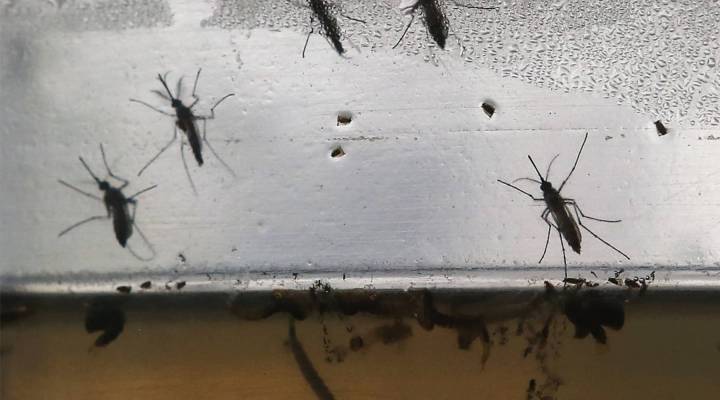
The mosquito business is buzzing

The United States is at war, and has been for decades. We’ve used precision smart bombs, military bombers, and foot soldiers on the ground. You know the enemy. You know it way too well.
“We’ve got 714 named mosquito control districts in the United States,” said Joseph Conlon, a medical entomologist with the American Mosquito Control Association. Mosquito control districts are independent but tax funded, they operate like school boards or water utilities. Except they are about killing mosquitoes.
“The last reliable statistics we have is in 1999, they were spending around $235 million for a year,” said Conlon.
Budgets range from a few thousand to $20 million. Public health is one reason. “Dengue used to be quite prevalent in the United States, yellow fever used to be quite prevalent, as of 1935 we had 125,000 cases of malaria transmitted in the united states,” said Conlon.
The invention and adoption of air conditioning went a long way to keep transmission of mosquito-born diseases down, but control efforts have helped as well. As new diseases have emerged, the industry has grown. “The market increased in size significantly after 2002 when West Nile virus became endemic in the U.S.,” said Steve Burt, president of ADAPCO, a company that sells mosquito-control supplies. He estimates the industry grew about 30 percent in just two years.
“Prior to West Nile in the U.S., mosquito control was reserved for places like Florida or the Southeast,” said ADAPCO’s vice president of sales Jason Trumbetta. “And after West Nile virus became endemic you saw it in places you wouldn’t typically think of, like rural Pennsylvania.”
One of the larger mosquito control districts is in the Florida Keys, where Mike Doyle is executive director. A few weeks ago he put out a trap on one of the local islands. “We captured 250,000 mosquitoes in one night. That’s the equivalent of eight mosquito bites a second for 14 hours.” It’s the reason, he said, people didn’t move to Florida a couple hundred years ago. “If we didn’t have a mosquito control program in the keys, we would have a tourist season of three months a year instead of 12 months a year,” Doyle said.
Doyle spend about 10 million dollars a year to make the Florida Keys the Florida Keys instead of hell on earth. He does it in a lot of different ways.
“We have four helicopters that fly and put out about 500,000 pounds, a bit over $1 million worth, of granules that have a bacteria in them,” Doyle explained. The bacteria kill mosquitoes and black flies, they don’t harm people or other insects. “These helicopters are zooming like an acrobatic show back and forth across the roads and marshes and houses to drop these granules very strategically, with smart bomb precision into marshes.”
There are also trucks that spray pesticides as a fine mist. Doyle says that improved technology to control droplet size has reduced the amount of chemicals required compared to the blanket spraying of the past. Whereas large-scale mosquito control emerged after World War II along with the grandiose debut of modern chemistry, these days the focus is on efficiency and limited environmental impacts.
“Just 15, 20 years ago when we were using DC3 aircraft, we would need to put out almost 20 times as many gallons of product than we do now. We were using 16 to 20 ounces [of pesticide] an acre, now we use just seven-tenths of an ounce per acre,” he said. Workers maintain population surveys to determine when to spray strategically as opposed to maintaining a schedule of mass spraying.
In the keys as elsewhere, the most expensive battle is fighting the specific species of disease bearing mosquitoes that don’t breed in salt marshes but rather in plant saucers and other containers in people’s homes and back yards. “It’s like urban warfare. You have individual soldiers in this case inspectors going door to door and looking and finding instead of acres of dense mosquito larvae you find cups with ten or fifteen mosquito larvae each but there’s 1,000 cups in a 1,000 yards and so the amount of time it takes to kill those mosquitos per person is enormously higher,” said Doyle.
This is the fastest growing part of Doyle’s budget, and it’s the part no mosquito control district can do alone. Doyle urges people to prevent water from accumulating around the home in drains, gutters, plant saucers, uncovered boats — anywhere where water could stand for a few days allowing mosquitoes to breed. “The general public really does need to be involved in protecting their own health,” he said.
There’s a lot happening in the world. Through it all, Marketplace is here for you.
You rely on Marketplace to break down the world’s events and tell you how it affects you in a fact-based, approachable way. We rely on your financial support to keep making that possible.
Your donation today powers the independent journalism that you rely on. For just $5/month, you can help sustain Marketplace so we can keep reporting on the things that matter to you.


















